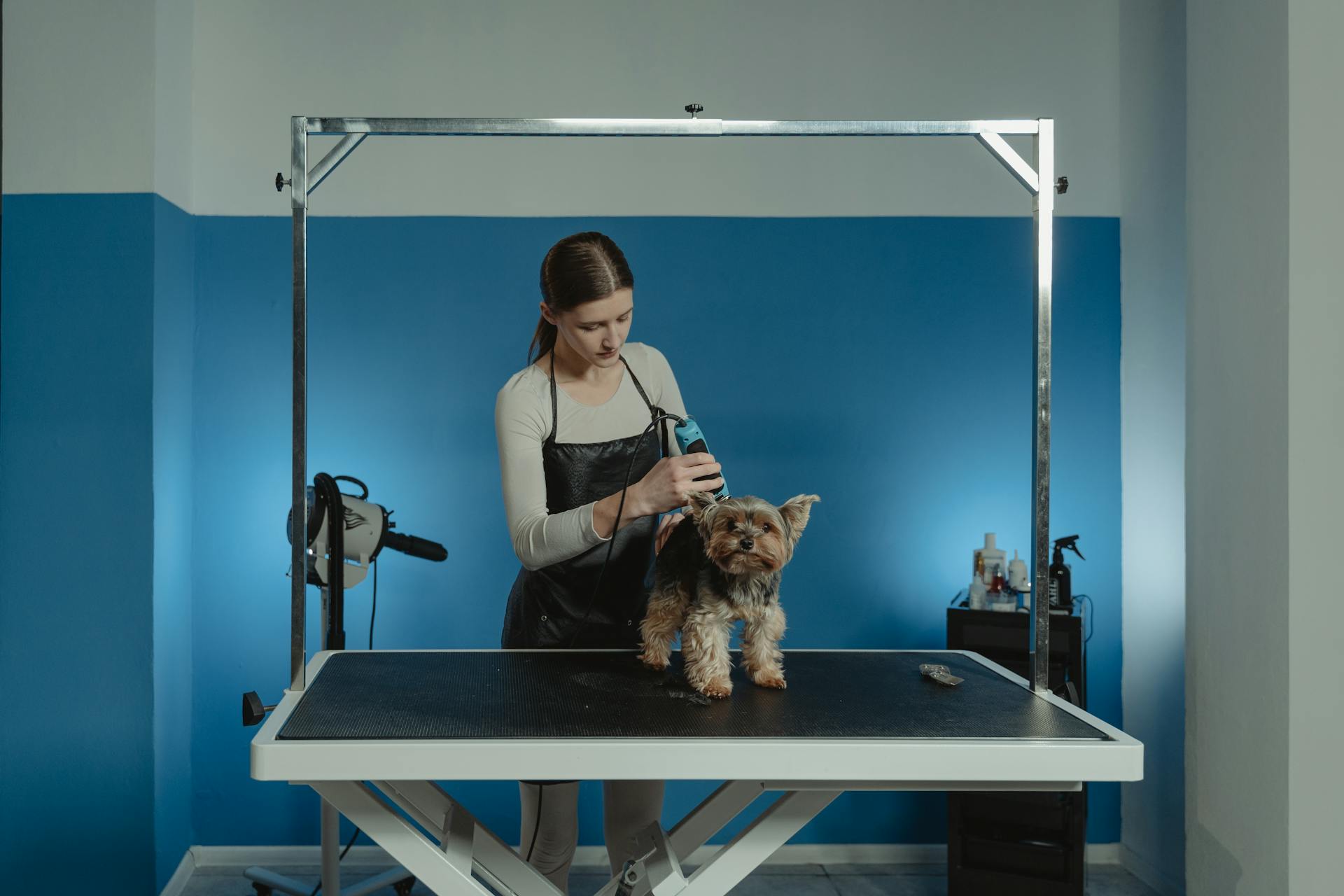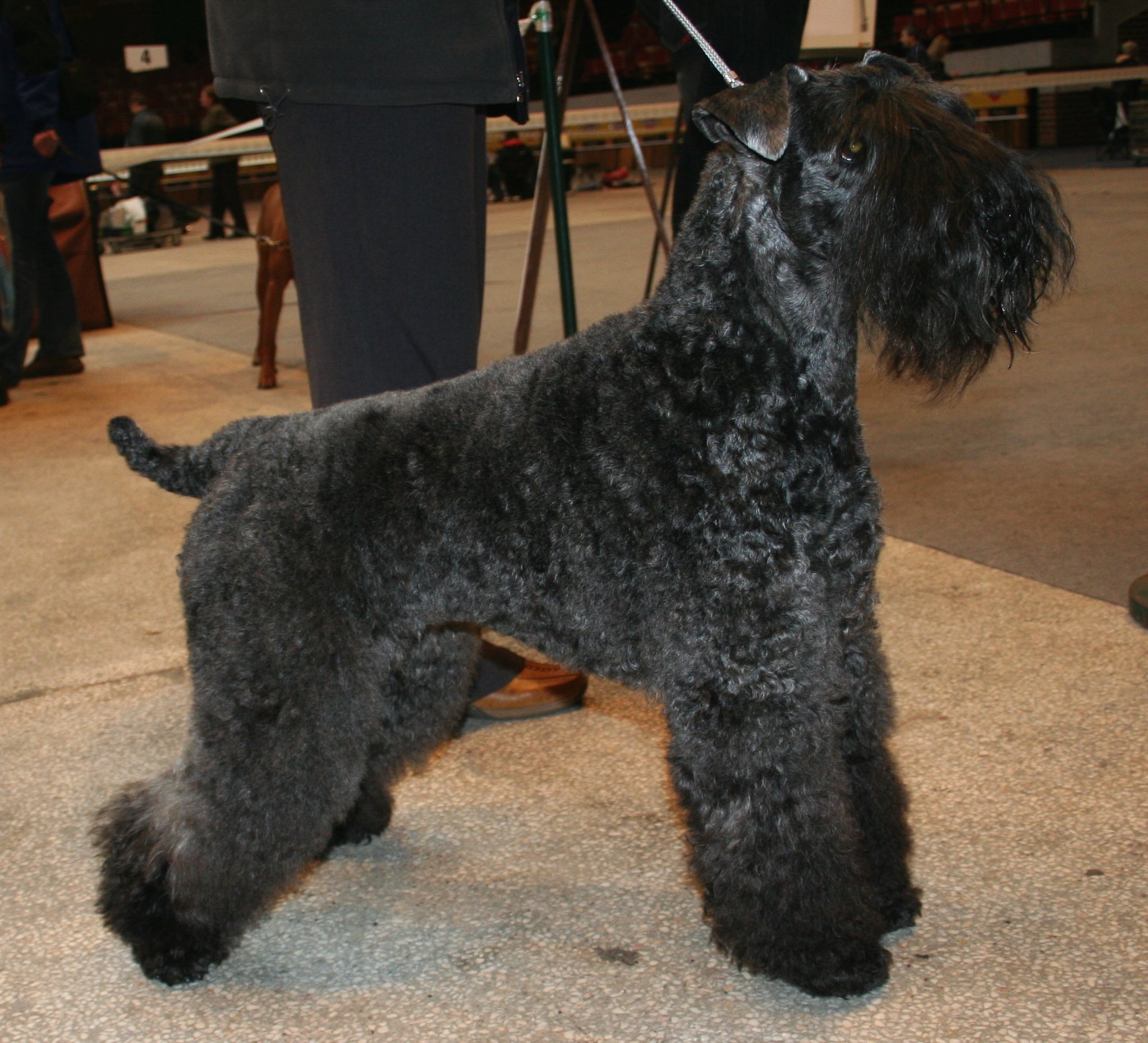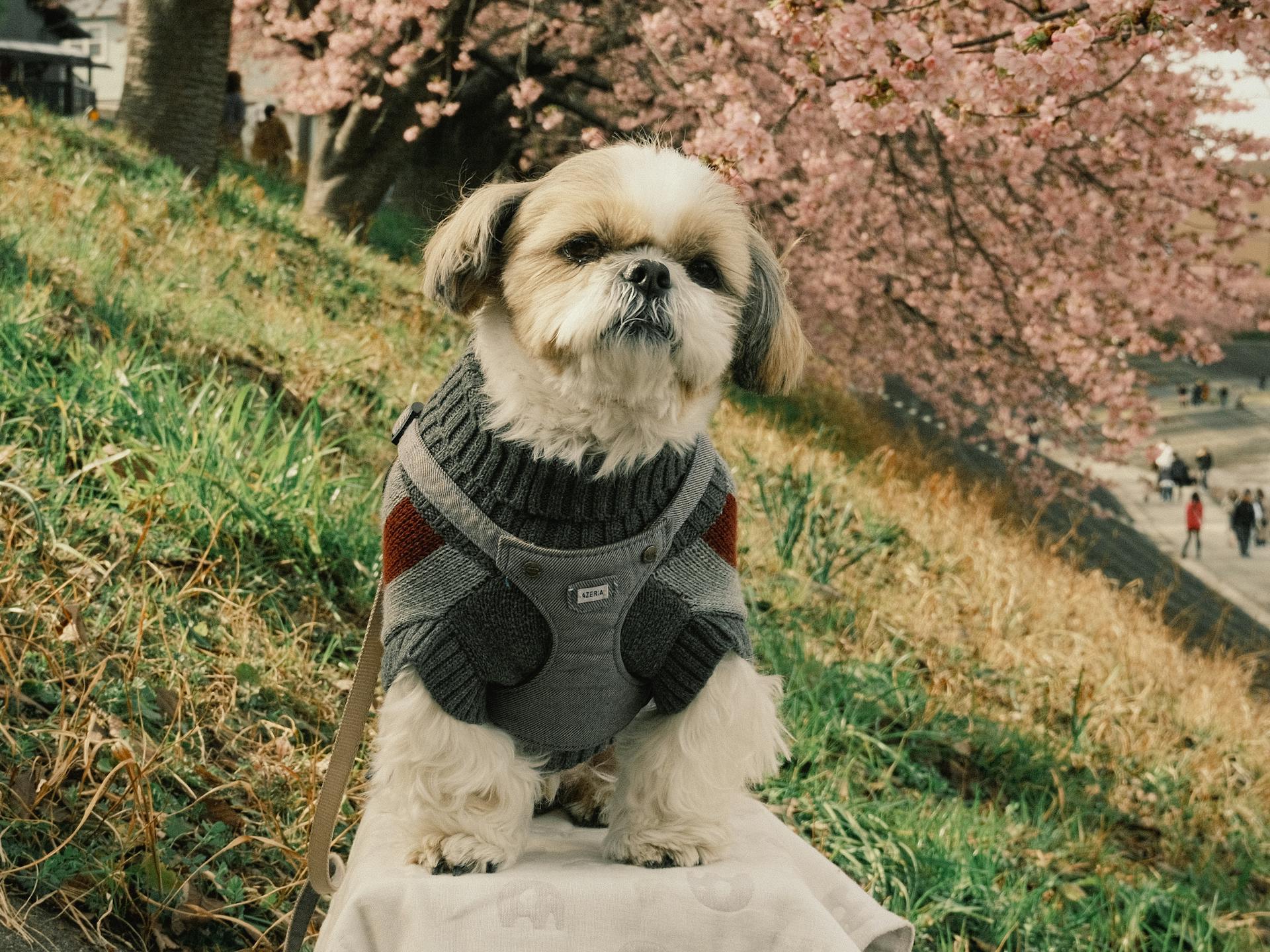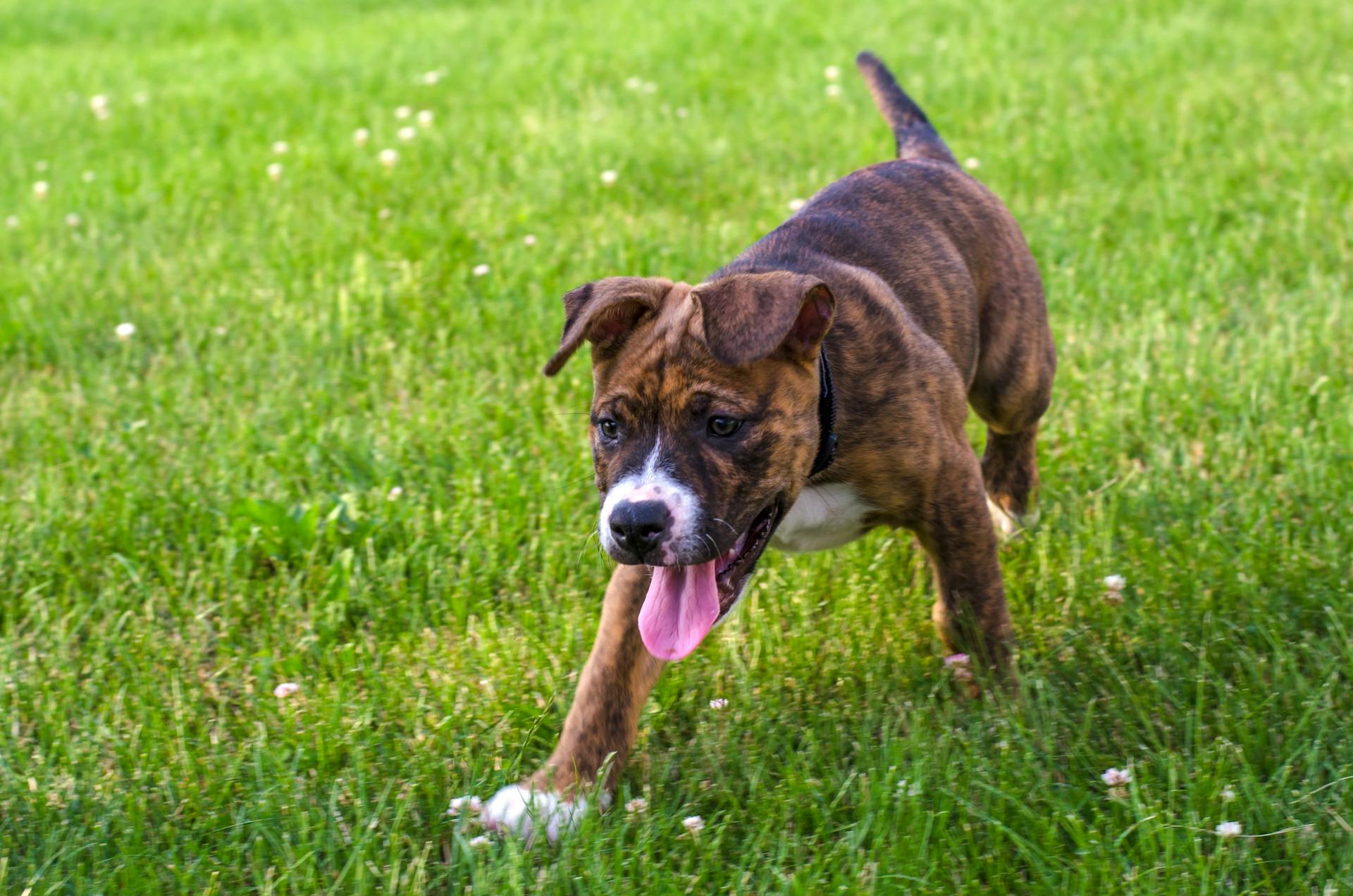
The Kerry Blue Terrier is a lively and affectionate breed that thrives on human interaction. They need regular exercise to stay happy and healthy.
To keep your Kerry Blue Terrier active, aim for at least 30 minutes of daily exercise, which can be a combination of walks, playtime, and training sessions. This will help them burn off excess energy and prevent destructive behavior.
Kerry Blue Terriers are intelligent and trainable, but they can be strong-willed at times. Consistent, positive reinforcement training is key to developing good behavior and strengthening your bond with your dog.
Intriguing read: Alaskan Malamute Behavior
Temperament and Care
The Kerry Blue Terrier is a breed that requires early socialization and training to become a well-behaved companion. They are independent and can be headstrong, so it's essential to establish a strong bond with them from an early age.
These dogs are highly intelligent and adaptable, capable of learning a variety of concepts and commands. They thrive on mental and physical stimulation, so it's crucial to provide them with plenty of exercise and engaging activities.
A Kerry Blue Terrier's diet is a crucial aspect of their care. They need a high-quality diet that's tailored to their age, and it's best to avoid giving them people food. Consistency is key, so stick to their regular feeding schedule.
To keep your Kerry Blue Terrier's coat looking sharp, regular grooming is a must. Brush their coat at least weekly, and trim their nails monthly. Clean their ears weekly, and brush their teeth at least twice a week to prevent tartar buildup.
Kerry Blue Terriers are naturally energetic and require plenty of exercise to keep them happy and healthy. They excel in dog sports like obedience, flyball, and agility, and need at least 30 minutes of exercise per day. A small yard is sufficient, but ensure the fence is high and secure, as they can be escape artists.
Here are some essential care tips for your Kerry Blue Terrier:
- Supervise your pet as you would a toddler, keeping doors closed and picking up after yourself.
- Brush their coat weekly and trim their nails monthly.
- Clean their ears weekly and brush their teeth at least twice a week.
- Provide at least 30 minutes of exercise per day, including mental stimulation.
- Stick to their regular feeding schedule and avoid giving them people food.
Remember, a Kerry Blue Terrier is a loyal companion that requires attention, exercise, and training. With patience, consistency, and love, they'll thrive as a beloved member of your family.
Health and Conditions
Kerry Blue Terriers are generally a healthy breed, but like all breeds, they can be prone to certain health issues.
Hip Dysplasia is a genetic condition that can cause arthritis and mobility problems. It's essential to keep your Kerry Blue Terrier at a healthy weight to minimize the risk of developing this condition.
Eye problems are common in Kerry Blue Terriers, including cataracts, dry eye, and entropion. Cataracts can cause blindness, but many dogs adjust well to losing their vision. Surgery to remove cataracts and restore sight may be an option.
Your Kerry Blue Terrier's kneecap can sometimes slip out of place, causing pain and discomfort. This condition is called patellar luxation, and it's more common in Kerry Blue Terriers. Treatment may involve arthritis medication or surgery.
Skin problems are another issue that can affect Kerry Blue Terriers, including Malassezia dermatitis, seborrhea, and sweat gland issues. These conditions can cause itching, redness, and discomfort, but they can often be treated with special shampoos and rinses.
You might enjoy: What Breed of Dog Has the Most Health Problems
It's crucial to be aware of the signs of illness in your Kerry Blue Terrier, including changes in appetite or water consumption, itchy skin, lethargy, and behavioral changes. If you notice any of these symptoms, seek veterinary help promptly.
Here are some common health issues that can affect Kerry Blue Terriers:
- Hip Dysplasia
- Cysts
- Warts
- Skin tumors
- Cataracts
- Dry eye
- Entropion
- Patellar luxation
- Malassezia dermatitis
- Seborrhea
- Sweat gland issues
Care and Lifestyle
To keep your Kerry Blue Terrier happy and healthy, it's essential to establish a routine that includes regular exercise and mental stimulation. They need at least an hour of dog exercise per day, ideally more, which can include walking, free running, and training that engages their exceptional brain.
A high-quality diet is crucial for your Kerry Blue Terrier's overall health. Feed a diet appropriate for their age, and avoid giving them people food. Consistency is key, so stick to their regular feeding schedule.
Kerry Blue Terriers require regular grooming to keep their coat looking sharp. Brush their coat at least weekly, and trim it monthly. They also need their teeth brushed at least twice a week to prevent dental problems.
To prevent boredom and destructive behavior, keep your Kerry Blue Terrier's mind and body active. Engage them in dog sports like obedience, flyball, and agility, or try scent games like hide-and-seek with treats.
Here are some essential exercise needs for your Kerry Blue Terrier:
- At least an hour of exercise per day, including walking and free running
- Two 30-minute walks per day, with a third walk if you're an apartment dweller
- Active exercise like playing fetch or jogging in the park at least once a day
- Consider enrolling them in dog sports or scent games for mental stimulation
Remember, Kerry Blue Terriers are highly alert and social dogs that require proper socialization, stimulation, and activity to stay happy. With a consistent routine and plenty of exercise, you'll be well on your way to raising a happy and healthy Kerry Blue Terrier.
Broaden your view: Boston Terrier Happy
Grooming and Maintenance
The Kerry Blue Terrier's grooming needs are a bit more high-maintenance than some other breeds, but with the right tools and routine, it's manageable.
A daily brushing session is a must to prevent mats and tangles from forming in their soft, silky coat. You'll also need to check over their coat regularly, paying particular attention to paws and ears where debris can collect.
You can trim your Kerry's coat every six to eight weeks to keep them looking their best, and a monthly bath is a good goal to keep them clean. Don't forget to brush their teeth daily and schedule regular nail trims and ear cleanings.
Here's a quick rundown of your Kerry's grooming needs:
Grooming and Maintenance
Kerry Blue Terriers have a high coat maintenance requirement, which means you'll need to brush and comb their fur regularly to prevent mats and tangles.
A good rule of thumb is to brush your Kerry Blue Terrier daily, using a comb and slicker brush to remove loose hair. This will help keep their coat looking its best and prevent any painful matting.
It's also essential to trim their fur every six to eight weeks to prevent overgrowth. You can use scissors or electric clippers for this, but it's a good idea to consult an experienced groomer for tips and guidance.
A monthly bath is a good goal for your Kerry Blue Terrier, as is a weekly nail trim and a twice-monthly ear cleaning. Your vet can help with these tasks and recommend the best cleansers for your dog's needs.
Don't forget to brush your Kerry's teeth every day using a toothpaste made for dogs, and schedule a professional teeth cleaning with your vet every year.
If you're not comfortable trimming your Kerry's fur yourself, it's always best to visit a professional groomer. They can give your dog a complete grooming every six to eight weeks, which includes a haircut, nail trim, and ear cleaning.
Here are some similar breeds to the Kerry Blue Terrier that also require regular grooming and maintenance:
These breeds all require regular grooming and maintenance, so it's essential to research their specific needs before bringing one home.
Appearance
The Kerry Blue Terrier is a stunning breed, and their appearance is just one of the many things that sets them apart. Their muscular body and long head make them a medium-sized dog with a lot of character.
Their coat is a key part of their charm, with a soft, dense, and wavy texture that's perfect for a breed that's often described as hypoallergenic. This means they don't shed much, making them a great choice for people with allergies.
Their coat color can range from black to deep slate blue to lighter blue-gray to silver, and they often have black or deep blue points on their head, muzzle, feet, and tail. As they mature, their coat may lighten, but these points usually remain.
Kerry Blue Terriers have small, dark, and rounded eyes that are alert and full of life. Their nose is black with wide, large nostrils, and their ears are V-shaped and moderately thick, folding over at the top.
Here are some key features to look out for when it comes to the Kerry Blue Terrier's appearance:
- Ears: V-shaped, moderately thick, and fold over at the top.
- Eyes: Small, dark, and rounded.
- Nose: Black with wide, large nostrils.
- Coat Length: Soft, dense, and wavy.
- Coat Color: Ranges from black to deep slate blue to lighter blue-gray to silver.
- Tail: Set high and carried very straight.
Overall, the Kerry Blue Terrier's appearance is a perfect blend of function and form, making them a beautiful and charming breed to be around.
Puppies and Ownership
Kerry Blue Terrier puppies are born black and develop their blue coat slowly over time.
Locating a Kerry Blue Terrier can be a challenge, as they are not very common dogs. You might need to travel to find a breeder.
Getting a puppy from a reputable licensed breeder with a history of healthy litters is highly recommended.
Puppies
Kerry Blue Terrier puppies are born black and develop their blue coat slowly over time. It's amazing to watch them grow into their unique coat.
Locating a Kerry Blue Terrier puppy might be a challenge due to their relative rarity. You may need to travel to find a reputable breeder.
The Kerry Blue Terrier is exceptionally intelligent, even as a puppy. This makes them a joy to train and interact with.
Buying from a reputable licensed breeder is highly recommended to ensure a healthy puppy. A good breeder will have a history of healthy litters and help your puppy learn the ropes.
Worth a look: Healthy Bull Terrier
Owning a Pet
Owning a pet is a big responsibility, but it's also incredibly rewarding.
You'll need to consider factors like your lifestyle, living situation, and budget before bringing a new furry friend home. The cost of owning a pet can be substantial, with estimates ranging from $500 to $1,000 per year.
Puppies require regular exercise and training, which can be time-consuming, especially for first-time owners. According to the article, a puppy needs at least 1-2 hours of exercise and training per day.
Some breeds are better suited for apartment living than others, so it's essential to research the needs of different breeds before making a decision. For example, small breeds like the Chihuahua or Poodle may be a better fit for city dwellers.
Puppies also require regular veterinary check-ups to stay healthy and prevent diseases. The article notes that vaccinations typically cost between $50 to $100 per session.
Whether you're a seasoned pet owner or a first-time parent, owning a pet can bring immense joy and companionship into your life.
Consider reading: Owning a Shiba Inu
Health and Nutrition
Kerry Blue Terriers are known to be generally healthy dogs, but like any breed, they can be prone to certain health issues. Their lifespan is typically between 12 to 15 years.
One of the most common health concerns for Kerry Blue Terriers is hip dysplasia, a genetic malformation of the hip that can cause pain and arthritis. Regular exercise and a healthy weight can help manage this condition.
Brushing your dog's teeth daily is crucial to prevent periodontal disease and keep their teeth healthy. This simple habit can go a long way in maintaining your Kerry's oral health.
Kerry Blue Terriers can also be prone to eye conditions such as cataracts and dry eye. Regular veterinary check-ups can help detect these issues early on.
Here are some common health issues that Kerry Blue Terriers may face:
- Hip Dysplasia
- Cataracts
- Dry Eye (Keratoconjunctivitis Sicca)
- Neurological Disorders (Degenerative Myelopathy and Progressive Neuronal Abiotrophy)
- Blood Conditions (Hemolytic Anemia and Thrombocytopenia)
- Inflammatory Bowel Disease
- Hypothyroidism
A balanced diet is essential for maintaining your Kerry Blue Terrier's overall health. They require a nutrient-dense, high-protein recipe that meets their nutritional needs. You can choose from a variety of dog food options, including raw meals, fresh food subscriptions, canned dog food, and dry kibble.
Remember to feed your Kerry at least twice daily and in accordance with the feeding guidelines of their particular food. Regular body condition scores can help ensure you keep your dog in ideal shape.
Treats are a great way to reward your Kerry during training, but be sure not to overdo it, as this can lead to excessive weight gain.
Training
The Kerry Blue Terrier is a smart breed that responds well to training, but they can also be a bit stubborn at times due to their terrier nature.
Their intelligence and love for engaging with their family make them a joy to train, but you'll need to be consistent and patient.
Kerry Blue Terriers thrive on positive reinforcement and are quick learners if they believe the training was their idea.
Early socialization is essential, especially with other dogs, children, and livestock, to help them adjust to family life at home.
However, they may not mix well with cats, especially outside the comfort of their own home.
A well-socialized Kerry Blue Terrier can excel in various canine sports and activities, but their feisty nature means owners should always be aware of potential challenges.
Consider enrolling your pup in puppy school to help them learn to play nicely with other puppies and meet other pet parents in a controlled environment.
General Information
The Kerry Blue Terrier is a highly spirited and animated breed that originated in Ireland at least 150 years ago. They were bred as an all-purpose working farm dog.
They are highly intelligent, playful, and energetic, making them great companions for active families. Good with children, they are protective of family and make good watchdogs.
Here are some key characteristics of the Kerry Blue Terrier breed:
- Highly intelligent
- Playful and energetic
- Good with children
- Protective of family
They are bold, steady, and fearless, but can be easily bored if not given something to do, which leads to barking and chewing. This means they require plenty of exercise and mental stimulation to prevent destructive behavior.
Breed History

The Kerry Blue Terrier breed has a rich history that spans over two centuries. Originating in County Kerry, Ireland in the 1700s, these dogs were bred to hunt vermin and small game.
Their impressive performance in dog shows earned them the National Dog of Ireland title, which remains in place today. The breed was recognized by the AKC in 1924.
Kerry Blue Terriers were originally bred as all-purpose working farm dogs, used for hunting, herding, controlling vermin, and guarding the home. They were also used by Irish laborers to poach game on noble grounds, earning them a reputation as stealthy and effective hunters.
The breed's versatility and strong work ethic have made them a popular choice for police work in Ireland, where they are known as Irish Blue Terriers.
Here are some key facts about the Kerry Blue Terrier breed:
Kerry Blue Terriers are known for their strong hunting instincts, which can make them a challenge to train and manage. However, with the right care and attention, they can thrive as beloved family pets.
Final Thoughts

The Kerry Blue Terrier is a rare breed, so be prepared to travel to find one if you're not lucky enough to find a reputable breeder near you.
They're incredibly intelligent and athletic, making them a great companion for active lifestyles. If you're an active person, the Kerry can certainly keep up with you.
These dogs are sturdy and can work well in various lifestyles, but they may not be the best fit for novice owners or sedentary individuals. They require a lot of exercise and mental stimulation to prevent boredom and destructive behavior.
The Kerry Blue Terrier can thrive in a variety of living situations, but they do require regular exercise and attention to stay happy and healthy.
Frequently Asked Questions
Do Kerry Blue Terriers bark a lot?
Yes, Kerry Blue Terriers are known to be quick to bark, making them a vocal breed. If you're considering bringing one home, be prepared for a lively companion that may keep you on your toes.
Are Kerry Blue Terriers cuddly?
Kerry Blue Terriers are affectionate and loving towards their family, making them great cuddle companions. However, proper socialization is key to bringing out their friendly side
Are Kerry Blue Terriers rare?
Yes, Kerry Blue Terriers are a relatively rare breed. Their uniqueness makes them a great choice for owners looking for a distinctive companion.
Is a Kerry Blue Terrier a good family dog?
Kerry Blue Terriers can make great family dogs, especially with children, due to their gentle nature. However, proper socialization is crucial to ensure they get along with other pets and family members
Can Kerry Blue Terriers be left alone?
Kerry Blue Terriers should not be left alone for extended periods, even in a securely fenced area. Early socialization is crucial to prevent potential aggression towards other dogs.
Sources
Featured Images: pexels.com


